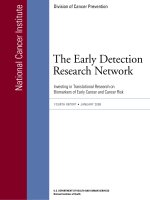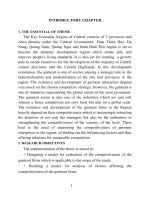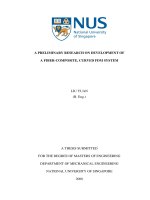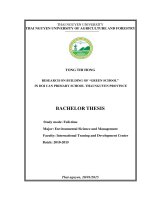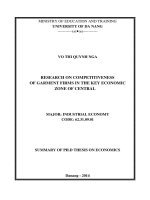Research on micropropagation of green rose (Rosa L.)
Bạn đang xem bản rút gọn của tài liệu. Xem và tải ngay bản đầy đủ của tài liệu tại đây (309.2 KB, 8 trang )
Biotechnology and Seedling
RESEARCH ON MICROPROPAGATION OF GREEN ROSE (Rosa L.)
Bui Thi Thu Huong1, Nguyen Mai Thom1, Dong Huy Gioi1*
1
Vietnam National University of Agriculture
SUMMARY
Green rose (Rose L.) is a beautiful, precious flower that is loved by many people all over the world. However,
the source of seedlings of the ornamental flower variety is very limited. This study was conducted to rapidly
propagate green roses by tissue culture. A solution of 0.1% HgCl2 was used to sterilize the samples; some plant
growth regulators such as BA, Kinetin, and nanosilver were used to improve the efficiency of in vitro
propagation. The results showed that (i) the using the solution HgCl₂ 0.1% for sterilizing the shoots in 10 minutes
gave a high rate of clean, survival samples, nearly 69%; (ii) the MS medium supplemented with 30 g/L sucrose,
8 g agar, 1.5 mg/L BAP, and 6 ppm nanosilver was the best for shoot regeneration with regeneration rate was
95.56%, and average shoot height was approximately 3 cm after 2 weeks of culturing, (iii) the most suitable
medium for shoot multiplication was the MS medium supplemented with 30 g/L of sucrose, 8 g/L agar, 1.5 mg/L
BAP, and 0.25 mg/L Kinetin with a coefficient of 2.65, and the average shoot height was 2.25 cm, (iv) the shoots
can have the best induction of rooting as culturing in the MS medium added 2 mg/L α-NAA, and 2 ppm nanosilver
with the rooting rate was 76.67%, and average root length was around 3.3 cm after 4 weeks culturing.
Keywords: green rose, in vitro micropropagation, nanosilver, plant grow regulator.
1. INTRODUCTION
Roses have been grown for a long time and
associated with human's lives in various aspects
such as romantic motels decorated with a bit of
crimson, a little bright yellow, solemn places
with peacock departments, partying, and
gardens filled with beautiful color and
fragrance. The green rose is a species of the
genus Rosa (Rosaceae family) in which
pigments range from blue to purple. With green
color, although it only recently appeared, the
spread and love of people for this flower is
increasing quickly. It not only has a luxurious
beauty but also carries many great meaningful
values. Green roses are no exception with a high
spiritual, aesthetic, and economic value.
In general, the demand for fresh flowers,
especially flowers with beautiful and exotic
colors like roses, is increasing significantly
worldwide. However, there exists a difficult
problem in breeding the new persimmon variety
for the domestic market and export. One kind of
green rose (Rosa x odorata), green aging to
purplish green, collected in Bali Botanical
Garden, was only studied on vegetative
reproduction with quite a low efficiency
(Siregar et al., 2005). Besides, it is said that in
vitro propagation of roses could multiply rapidly
*Corresponding author:
20
cultivars with desirable traits and production of
healthy and disease-free plants. During the last
several years, scientists are witnessing several
approaches for rose micropropagation.
However, it is always challenging to find a
suitable protocol and refinements with a high
rate of shoot multiplication and a cost-effective
method for a valuable variety (Rashida et al.,
2003). Therefore, many findings of rose
micropropagation have been reported for a long
time, such as Nikbakht et al. (1560) to now
(Siregar et al., 2005; Hameed et al., 2008;
Naphaporn, 2009; Murali & Sindhu, 2011;
Zeng et al., 2013; Nguyen & Van Le, 2020).
To develop the flower, the application of
tissue culture could rapidly propagate this
valuable green rose in a short time.
2. RESEARCH METHODOLOGY
2.1. Material: Green rose plants grown and
preserved in the Vietnam National University of
Agriculture.
Figure 1. Green rose plant
JOURNAL OF FORESTRY SCIENCE AND TECHNOLOGY NO. 11 (2021)
Biotechnology and Seedling
2.2. Methods
2.2.1. Sample sterilization: According to
Nguyen Ngoc Quynh Tho et al. (2018), HgCl₂
0.1% was an appropriate chemical to sterilize
rose plant samples. Therefore, before being
treated by the HgCl2 as the primary substance
for sterilization, the segments carrying stems
were washed under running water, soaked in a
diluted soap for 15 minutes and then rinsed with
distilled water 2 times in the sterilizing box, and
rinsed the sample with 70˚ alcohol solution for
1 minute and lastly rinsed with distilled water.
Specifically, the sample was sucked with HgCl2
0.1% in different periods like 5, 10, 15, or 20
minutes and cultured in the MS medium in one
week. They were assessed with the survival rate
(total number of survival samples/total samples
× 100%) and the rate of clean survival samples
(total number of clean survival samples/total
samples × 100%).
2.2.2. Regeneration
a. Effect of BAP on shoot regeneration:
Nguyen Thi Phuong Thao (2015) used the
MS medium supplemented with BAP for
making up the highest rate of regeneration of
rose samples in this stage. In this study, the MS
medium supplemented with 8 g/L agar, 30 mg/L
sucrose, and BAP (with different concentrations
such as 0, 0.5, 1.0, 1.5, or 2.0 mg/L) was used
to generate shoots in vitro. After 2 weeks, figure
out the germination rate (the total number of
germinated samples/total samples × 100%); the
average height of shoot (cm).
b. Effect of silver on shoot regeneration
Ha Ngan Thi My et al. (2020) showed that
silver nanoparticles could enhance the growth
of Rosa Hybrida L. ‘Baby Love’ roses, and
stimulate mass shoot propagation, rooting in
vitro. Thus, the rose samples were cultured into
the best medium of the previous experiment
with BAP and supplemented with nanosilver
(NS) with one of the following concentrations
such as 0, 2, 4, 6, or 8 ppm. After 2 weeks,
analyze the shoot multiplication coefficient (%),
shoot’s average height (cm).
2.2.3. Multiplication in vitro
a. Effect of BAP on shoots multiplication
The MS added 1.5 mg/L BAP was evaluated
as the best medium for shoot proliferation of
rose samples in vitro (Hameed et al., 2006; Bui
Thi Thu Huong et al., 2017). Therefore, the MS
medium supplemented with 8 g/L agar, 30 g/L
sucrose, and BAP ranged from 0, 0.5, 1.0, 1.5,
or 2.0 mg/L BAP. After 4 weeks, collect the
shoot regeneration rate (total number of shoot
regeneration samples/ total samples × 100%),
shoot average height (cm).
b. Effect of Kinetin on shoots multiplication
The finding of our previous publications of
in vitro multiplication of Sapa roses (Rosa
gallica L.) (Bui Thi Thu Huong et al., 2017)
illustrated that 91.67% of the Sapa roses’
sample formed shoots on the culturing medium,
the MS added 1.5 mg/L BAP and 0.5 mg/L
Kinetin. The green rose shoots were also put on
the MS medium and 8 g/L agar, 30 g/L sucrose
supplemented with 1.5 mg/L BAP, and added
Kinetin with the following different
concentrations as 0, 0.25, 0.5, 0.75, or 1.0 mg/L.
After 4 weeks, find out the shoot regeneration
rate (total number of shoot regeneration
samples/total samples × 100%); shoots average
height (cm).
2.2.4. Rooting
In 2005, Nguyen Thi Kim Thanh et al.
studied white roses’ tissue culture and reported
that MS medium supplemented with 2 mg/L αNAA gave the rooting efficiency over 60%.
Moreover, our previous finding of culturing the
Sapa roses’ shoots on MS medium
supplemented with 2 mg/L α-NAA and 2 ppm
NS demonstrated that the rooting rate increased
with the rate of 76.67% (Bui Thi Thu Huong et
al., 2017). It navigated our experiment in which
in vitro rose shoots were cultured in the MS
medium containing 2 mg/L α-NAA and added
nanosilver with different concentrations like 0,
2, 4, 6, or 8 ppm. After 4 weeks, the root
regeneration rate (total number of roots / a shoot
× 100%); roots’ average length (cm), and their
main characteristics were analyzed.
JOURNAL OF FORESTRY SCIENCE AND TECHNOLOGY NO. 11 (2021)
21
Biotechnology and Seedling
2.2.5. Experiment condition and data analysis
The experiments were conducted at the
Vietnam National University Agriculture, from
2020 to 2021. All the medium was adjusted to
pH 5.8 and autoclaved at 1 atm, 121˚ in 20
minutes. The sample was illuminated with
around 2500 lux in 16 hours at 25 ± 2˚C,
humidity 70 - 80%. All experiments were
repeated 3 times with 15 samples per formula
each time, then observed and evaluated the
figures for some weeks of culture depending on
a particular situation. Data is processed
according to software MICROSOFT EXCEL
and statistical software IRRISTAT 5.0.
3. RESULTS AND DISCUSSIONS
3.1. Sample sterilization
To create in vitro materials of green rose
plants, the stem segments were sterilized by
HgCl2 0.1% in 5, 10, 15, or 20 minutes; then
were cultured in the MS medium. The obtained
results of sterilized samples a week later were
shown in Table 1.
Table 1. Effect of HgCl2 on nodal segments of green rose
Time
Survival rate
Clean, survival rate (%)
(minutes)
(%)
5
95.56
44.44
10
91.11
68.89
15
75.56
57.78
20
71.11
51.11
Table 1 shows that after 2 weeks of culturing,
the percentage of survival samples sterilized at
different times ranged from 71.11% to 95.56%
and the clean survival rate from 44.44% to
68.89%. Among them, 10 minutes of treatment
by HgCl2 0.1% led to the highest clean survival
rate, 68.89%. It was quite like the research of
Nguyen Ngoc Quynh Tho et al. (2018) in which,
bud segments were disinfected by 0.2% HgCl2
in 10 minutes, and the percentage of uninfected,
survivals reached 71.67%.
Compared to the research of Banyal et al.
(2015), who developed an efficient protocol for
sterilizing axillary bud segments of Rosa ×
hybrida L. cv. Happiness with T1 pre-treatment
comprising 0.2% Carbendazim,
0.2%
Mancozeb-45, and 150 mg/L8-HQC in 4
radiation on a horizontal shaker (200 rpm),
which resulted in 80.25% of survival explants.
This experiment had similar findings when a
different chemical, HgCl2 0.1% was used for
rose explants’ sterilization.
3.2. The possibility to regenerate in vitro shoots
The effect of BAP on stem segments’ green
rose to regeneration shoots was described in
Table 2 after 2 weeks of culturing.
The results obtained in Table 2 and Figure 2
show that, after 2 weeks of culturing, the MS
medium with 1.5 mg/L BAP made up the
highest shoot regeneration rate, 88.67%, and the
shoot height was also the highest, 2.05 cm.
Table 2. Effect of BAP on shoot regeneration of green roses’ nodal segments
BAP (mg/l)
Regeneration rate (%)
Shoot height (cm)
Shoot characteristics
0
0.5
56.33d
66.67c
1.22d
1.48c
Small, green shoots
Small, green shoots
1.0
80.67b
1.80b
Quite big, green shoots
1.5
2.0
a
88.67
69.33c
a
2.05
1.82b
LSD0.05
CV(%)
6.70
1.30
0.23
3.90
Big, green shoots
Big, light green shoots
In the same column, the value with the different letters was shown significantly differently at p = 0.05.
22
JOURNAL OF FORESTRY SCIENCE AND TECHNOLOGY NO. 11 (2021)
Biotechnology and Seedling
0 mg/L BAP
0.5 mg/L BAP
1.0 mg/L BAP
1.5 mg/L BAP
2.0 mg/L BAP
Figure 2. Shoots on the MS medium supplemented with BAP after 2 weeks of culturing
However, Duong Tan Nhut et al. (2015)
declared that MS medium supplemented 7 mg/L
nanosilver (NS) gave a better effect on their
roses’ sample than that without NS. The result
was consistent with this experiment shown in
Table 3, Figure 3 in which the medium with 6
or 8 ppm NS took the highest rate of shoot
regeneration. However, the shoots in the
medium with 8 ppm NS had yellow leaves. So,
the medium with 6 ppm NS was optimal for the
roses’ shoot regeneration. Similarly, Ha Ngan
Thi My et al. (2020) explained that NS could
improve the growth of Rosa Hybrida L. ‘Baby
Love’ in the different concentrations. Dong Huy
Gioi and Duong Thi Men (2017) also reported
that more than 91% of Sapa nodal explants
formed shoots on the medium added 2 ppm NS.
Table 3. Effect of nanosilver on shoot regeneration of green roses’ nodal segments
Nano silver
Regeneration
Shoot height
Shoot characteristics
(ppm)
rate (%)
(cm)
0
84.44c
2.1c
Small, green shoots
b
2
86.67
2.4b
Small, light green shoots
b
a
4
88.89
2.6
Quite big, light green shoots
6
95.56a
2.8a
Big, light green shoots
a
a
2.7
Big, light green shoots with yellow leaves
8
95.56
LSD0.05
1.89
0.34
CV (%)
1.20
6.9
In the same column, the value with the different letters was shown significantly differently at p = 0.05.
0 ppm NS
2 ppm NS
4 ppm NS
6 ppm NS
8 ppm NS
Figure 3. Shoot on the MS medium supplemented 1.5 mg/l BAP
and nanosilver (NS) after 2 weeks of culturing
3.3. Shoot multiplication
The in vitro shoots were cultured in the MS
medium with BAP to multiply shoots. After 2
weeks, the data were collected and were shown
in Table 4, and Figure 4 as well. After 2 weeks
of culturing, the MS medium with 1.5 mg/L
BAP was the best suitable to multiply shoots.
It made up the highest shoot multiplication
coefficient, 2.4, and the average shoot height
was 2.02, and the number of new leaves of each
shoot was 4.2. It was likely to be analogous to
our research in 2017 on the Sapa roses (Rosa
gallica L.), which illustrated the best result of
multiplication as culturing in the MS medium
added 1.5 mg/L BAP (Bui Thi Thu Huong et
al., 2017).
JOURNAL OF FORESTRY SCIENCE AND TECHNOLOGY NO. 11 (2021)
23
Biotechnology and Seedling
Table 4. Effect of BAP on shoot multiplication of green roses’ shoots
Shoot
Average
Number of
BAP
multiplication
shoot height
leaves/
Shoot characteristics
( mg/L)
coefficient
(cm)
shoot
0
1.06d
1.30c
2.7c
Small shoots, green leaves
c
b
0.5
1.50
1.60
3.1bc
Small shoots, green leaves
1.70b
3.5b
Quite big shoots, green leaves
1.0
1.70b
1.5
2.40a
2.02a
4.2a
Big shoots, green leaves
2.0
1.40c
1.40c
3.3b
Quite big shoots, yellow leaves
0.24
0.19
0.36
LSD0.05
CV (%)
5.85
5.70
4.00
In the same column, the value with the different letters was shown significantly differently at p = 0.05.
0 mg/L BAP
0.5 mg/L BAP
1.0 mg/L BAP
1.5 mg/L BAP
2.0 mg/L BAP
Figure 4. Shoot on the MS medium supplemented with BAP after 4 weeks of culturing
Besides, the MS medium with BAP and
Kinetin would positively affect shoots in vitro
to multiply. The experiment’s results
demonstrate the fact shown in Table 5, Figure
5, after 4 weeks of culturing. Although the MS
medium with 1.5 mg/L BAP and 0.5 mg/L
Kinetin was the most suitable for Rosa indica L.
(Shabbir et al., 2009) and Sapa rose (Bui Thi
Thu Huong et al., 2017), the results obtained in
Table 5 and Figure 5 illustrates that the medium
with 1.5 mg/L BAP and 0.25 mg/L Kinetin was
optimal for these samples in multiplication in
vitro. Specifically, the shoot multiplication
coefficient was 2.65, and the average shoot
height was 2.25, with the number of new leaves
of each shoot reaching over 4.
Table 5. Effect of Kinetin on shoot multiplication of green roses’ shoots
Shoot
Average shoot
Kinetin
Number
multiplication
height
Shoot characteristics
(mg/l)
leaves/shoots
coefficient
(cm)
0
2.07c
2.03c
3.6c
Small, green shoots
a
a
0.25
2.65
2.25
4.3a
Big, green shoots
0.50
2.30b
2.14b
4.0b
Big, green shoots
b
bc
b
0.75
2.33
2.07
3.8
Big, yellow shoots
1.00
2.10c
2.02c
3.5c
Big shoots, yellow leaves
LSD0.05
0.24
0.10
0.27
CV (%)
6.80
1.30
4.3
In the same column, the value with the different letters was shown significantly differently at p = 0.05.
0.25 mg/L Ki
0.5 mg/L Ki
0.75 mg/L Ki
1.0 mg/L Ki
1.25 mg/L Ki
Figure 5. Shoots on the MS medium with 1.5 mg/L BAP and Kinetin (Ki) after 4 weeks of culturing
24
JOURNAL OF FORESTRY SCIENCE AND TECHNOLOGY NO. 11 (2021)
Biotechnology and Seedling
3.4. Rooting
According to Ha Ngan Thi My et al. (2020),
nanosilver (NS) enhanced the growth of Rosa
hybrida L. ‘Baby Love and stimulated their
rooting. It was likely to be similar for the green
rose as well as when shoots were culturing in the
MS medium with 2 mg/L NAA and NS at 2, 4,
6, or 8 ppm (shown in Table 6 and Figure 6).
Table 6. Effect of nanosilver on shoot rooting of green roses’ shoots
Nanosilver
Rooting rate
Average root
Roots’ characteristic
(ppm)
(%)
length (cm)
0
60.00c
2.24d
Big roots
a
a
2
76.67
3.36
Quite big roots
4
64.33b
2.94b
Thin roots
2.66c
Thin roots
6
56.67d
e
d
8
46.67
2.42
Thin roots
LSD0.05
CV (%)
1.93
6.70
0.27
0.72
In the same column, the value with the different letters was shown significantly differently at p = 0.05.
0 ppm NS
2 ppm NS
4 ppm NS
6 ppm NS
8 ppm NS
Figure 6. Shoots on the MS medium supplemented with 2 mg/L NAA
and nanosilver after 4 weeks of culturing
The report of Nguyen Thi Kim Thanh et al.
(2005) studying a white rose declared that MS
medium augmented with 2 mg/L α-NAA gave
the rooting efficiency over 60%. In this work,
the green roses’ shoots were cultured in the
same medium and added 2 or 4 ppm NS had
enlarged the rooting rates, 76.67%, and 64.33%,
respectively; and the average root length was
around 3 cm. In short, the ideal medium for
rooting the green roses’ shoots was MS medium
added 2 mg/L α-NAA and 2 ppm NS.
4. CONCLUSION
Sterilizing samples for 10 minutes in HgCl₂
0.1% was optimum to make clean survival
samples with the highest rate, 68.89%. Besides,
to regenerate new shoots, the MS added 6 ppm
nanosilver and 1.5 mg/L BAP was ideal with the
regeneration rate reaching 95.56%, average
shoot height was 2.8 cm. The MS medium
supplemented with 1.5 mg/L BAP and 0.25
mg/L Kinetin was the best suitable medium to
multiply shoots in vitro as well, with the
coefficient of 2.65, the average shoot height of
2.25 cm, and the number of leaves per shoot was
around 4. In the MS medium including 2 mg/L
α-NAA and 2 ppm nanosilver, 76.67% of shoots
could form roots with an average root length of
3.36 cm.
REFERENCES
1. Bui Thi Thu Huong, Dong Huy Gioi, Nguyen
Thi Trang, Ho Thi Quyen (2017). Cultivating Sapa
rose plant (Rosa gallica L.) by in vitro tissue culture
technique. 7th National Scientific Conference on
Ecology and Biological Resources.
JOURNAL OF FORESTRY SCIENCE AND TECHNOLOGY NO. 11 (2021)
25
Biotechnology and Seedling
2. Banyal N., Raju D. V. S., Prasad K. V., Singh
K. P., & Kumar, S. (2015). Standardization of
protocol for in vitro multiplication of rose (Rosa ×
hybrida) cv. Happiness. Indian Journal of
Agricultural Sciences 85 (11): 1513–1517.
3. Dong Huy Gioi and Duong Thi Men (2017).
Study on the use of nanoparticles in Sapa rose (Rosa
gallica L.) tissue culture. Journal of Vietnam
Agricultural Science and technology. 5(78): 59-65.
4. Duong Tan Nhut, Nguyen Xuan Tuan,
Nguyen Thi Thuy Anh, Ho Viet Long, Hoang Thanh
Tung, Nguyen Ba Nam, Nguyen Phuc Huy, Vu
Quoc Luan, Vu Thi Hien, Le Thi Thu Hien, Nguyen
Hoai Chau, Ngo Quoc Buu (2015). Effect of
nanosilver on shoot multiplication, growth and
development of in vitro rose (Rosa sp.). Journal of
Biotechnology 13 (2): 231-239, 2015.
5. Ha Ngan Thi My, Manh Do Cuong, Hoang
Tung Thanh, Ngo Nghiep Dai, Van Bui Le,
Duong Tan Nhut (2020). The effect of cobalt and
silver nanoparticles on overcoming leaf abscission
and enhanced growth of rose (Rosa hybrida L.
‘Baby Love’) plantlets cultured in vitro. Plant Cell,
Tissue, and Organ Culture, Dordrecht. 141 (2): 393405. DOI:10.1007/s11240-020-01796-4.
6. Hameed N., Shabbir A., Ali A., & Bajwa R.
(2008). In vitro micropropagation of disease free
rose (Rosa indica L.). Mycopath, 4, 35–38.
7. Kshirsagar A. (2014). Effect of BAP and
kinetin on nodal culture of Rosa hybrida L. Bionano
Frontier, 2: 254-257.
8. Murali R. & Sindhu K. (2011). In vitro
multiplication of rose (Rosa bourboniana). Int. J.
Res. 3(4): 100-103.
9. Naphaporn N.U., Kantamaht K. and
Kamnoon K. (2009). Micropropagation from
cultured nodal explants of rose (Rosa hybrid L. cv.
‘Perfume Delight’). Songklanakarin Journal of
Science and Technology, 31(6): 583-586.
10. Nikbakht, A., Kafi M., Mirmasoumi M., &
Babalar M. (1560). Micropropagation of Damask
rose (Rosa damascena Mill.) cvs. Azaran and
Ghamsar. International journal of agriculture &
biology, 8530, 7–4.
11. Nguyen N. H., & Van Le B. (2020). A simple,
economical, and high efficient protocol to produce
26
in vitro miniature rose. In Vitro Cellular &
Developmental Biology Plant, 56(3), 362–365.
/>12. Nguyen Ngoc Quynh Tho, Nguyen Duy
Khanh, Huynh Thi Anh Sang, Tu Van Ut, Truong
Quynh Yen Yen, Nguyen Thanh Luan, Trinh Thi
Huong (2017). Research to create an in vitro plant
of Saffron rose (Rosa chinensis Jacq. Var. Minima
Redh.). Journal of Science, Technology and Food 15
(1): 57-64.
13. Nguyen Thi Kim Thanh (2005).
Propagating Rose plants using in vitro
transplantation technique. Journal of Agriculture
and Rural Development, 1: 39-41.
14. Nguyen Thi Phuong Thao, Dang Quang
Bich, Nguyen Thi Thuy, Nguyen Thi Thuy Linh,
Pham Thi Thu Hang, Dang Thi Thanh Tam, Ninh
Thi Thao, Nguyen Thi Lam Hai, Nguyen Thanh Hai,
(2015). Fast multiplication and induction of rose
(Rosa sericea LINDL). J. Science. & Devel., 13(4):
606-613.
15. Nikbakht A., Kafi M., Mirmasoumi M., &
Babalar M. (1560). Micropropagation of Damask
rose (Rosa damascena Mill.) cvs. Azaran and
Ghamsar. International journal of agriculture &
biology, 8530, 7–4.
16. Rashida S., Shamsa Y., & Rizwana A.
(2003). In vitro Propagation of Rosa indica.
Pakistan Journal of Biological Sciences.
/>17. Shabbir A., Hameed N., Ali A., & Bajwa R.
(2009). Effect of different cultural conditions on
Micropropagation of Rose (Rosa indica L.).
Pakistan Journal of Botany, 41, 2877–2882.
18. Siregar H. M., Suendra I. P., & Siregar M.
(2005). Rosa x odorata “viridiflora” (green rose) in
Bali Botanical Garden: Biological phenology and its
propagation. Biodiversitas Journal of Biological
Diversity,
6(3).
/>19. Zeng S., Liang S., Zhang Y. Y., Wu K. L.,
Teixeira da Silva J. A., & Duan J. (2013). In vitro
flowering red miniature rose. Biologia Plantarum,
57(3): 401–409. />
JOURNAL OF FORESTRY SCIENCE AND TECHNOLOGY NO. 11 (2021)
Biotechnology and Seedling
NGHIÊN CỨU VI NHÂN GIỐNG CÂY HOA HỒNG XANH (Rosa L.)
Bùi Thị Thu Hương1, Nguyễn Mai Thơm1, Đồng Huy Giới1*
1
Học viện Nơng nghiệp Việt Nam
TĨM TẮT
Hoa hồng xanh (Rose L.) là một giống hoa đẹp, mới lạ và được rất nhiều người ưa thích. Tuy nhiên, nguồn cây
giống của giống hoa này còn rất hạn chế. Nghiên cứu này được thực hiện nhằm nhân nhanh giống hoa hồng xanh
bằng phương pháp nuôi cấy mô tế bào. Dung dịch HgCl2 0,1% được sử dụng để khử trùng mẫu nuôi cấy, các
chất điều tiết sinh trưởng như BAP, Kinetin và nano bạc được sử dụng để nâng cao hiệu quả của quá trình nhân
giống in vitro. Kết quả thu được cho thấy (i) Sử dụng dung dịch HgCl2 0,1% để khử trùng mẫu trong 10 phút cho
tỉ lệ mẫu sống sạchcao nhất, đạt gần 69%; (ii) mơi trường MS có bổ sung 30 g/L sucrose, 8 g/L agar, 1,5 mg/L
BAP và 6 ppm nano bạc là thích hợp nhất để tái sinh chồi hoa hồng xanh, với tỉ lệ tái sinh là 95,56% và chiều
cao chồi khoảng 3 cm sau 2 tuần ni cấy, (iii) mơi trường thích hợp nhất để nhân chồi là môi trường MS bổ
sung 30 g/L sucrose, 8 g/L agar, 1,5 mg/L BAP và 0,25 mg/L Kinetin với hệ số nhân là 2,65 lần và chiều cao
chồi trung bình là 2,25 cmsau 4 tuần ni cấy, (iv) chồi ra rễ tốt nhất khi nuôi cấy trong môi trường MS được bổ
sung 2 mg/L α-NAA và 2 ppm nano bạc với tỉ lệ chồi ra rễ là 76,67% và chiều dài rễ trung bình khoảng 3,3 cm
sau 4 tuần ni cấy.
Từ khóa: chất điều hịa sinh trưởng thực vật, hoa hồng xanh, nano bạc, vi nhân giống.
Received
Revised
Accepted
: 09/7/2021
: 12/8/2021
: 20/8/2021
JOURNAL OF FORESTRY SCIENCE AND TECHNOLOGY NO. 11 (2021)
27
